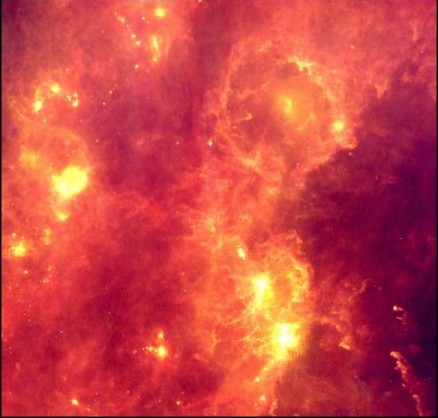Credit & Copyright: IRAS Project,
IPAC
Explanation:
Do you recognize the
constellation Orion?
This striking but unfamiliar looking picture of
the familiar
Orion region of the sky was produced
using survey data from the
InfraRed Astronomical Satellite (IRAS).
It combines information recorded
at three different
invisible infrared wavelengths
in a red, green, and blue color scheme
and covers about 30x24 degrees on the sky.
Most of Orion's visually impressive stars don't stand out,
but bright Betelgeuse
does appear as a small purplish dot just above center.
Immediately to the right of Betelgeuse and prominent in the IRAS
skyview,
expanding debris from a stellar explosion,
a supernova remnant,
is seen as a large bright ring-shaped feature.
The famous
gas clouds
in Orion's sword glow brightly as the yellow
regions at the lower right.
No longer operational,
IRAS used a telescope cooled by liquid
helium to detect
celestial infrared radiation.
1999 2000 2001 2002 2003 2004 2005 2006 2007 2008 2009 2010 2011 2012 2013 2014 2015 2016 2017 2018 2019 2020 2021 2022 2023 2024 2025 |
Yanvar' Fevral' Mart Aprel' Mai Iyun' Iyul' Avgust Sentyabr' Oktyabr' Noyabr' Dekabr' |
NASA Web Site Statements, Warnings, and Disclaimers
NASA Official: Jay Norris. Specific rights apply.
A service of: LHEA at NASA / GSFC
& Michigan Tech. U.
|
Publikacii s klyuchevymi slovami:
Orion - infrared - Orion - ostatok Sverhnovoi - infrakrasnoe izluchenie - Betel'geize
Publikacii so slovami: Orion - infrared - Orion - ostatok Sverhnovoi - infrakrasnoe izluchenie - Betel'geize | |
Sm. takzhe:
Vse publikacii na tu zhe temu >> | |
